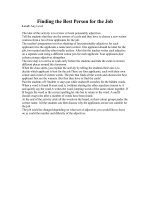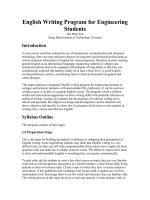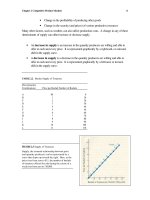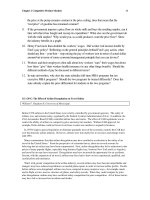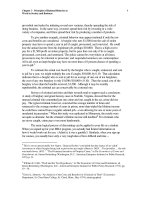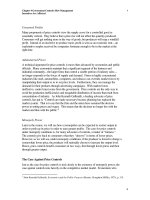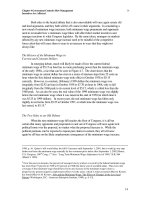External Audiences for Test-Based Accountability doc
Bạn đang xem bản rút gọn của tài liệu. Xem và tải ngay bản đầy đủ của tài liệu tại đây (186.03 KB, 36 trang )
This PDF document was made available from www.rand.org as a public
service of the RAND Corporation.
6
Jump down to document
Visit RAND at www.rand.org
Explore RAND Education
View document details
This document and trademark(s) contained herein are protected by law as indicated in a notice
appearing later in this work. This electronic representation of RAND intellectual property is provided
for non-commercial use only. Permission is required from RAND to reproduce, or reuse in another
form, any of our research documents for commercial use.
Limited Electronic Distribution Rights
For More Information
CHILDREN AND ADOLESCENTS
CIVIL JUSTICE
EDUCATION
ENERGY AND ENVIRONMENT
HEALTH AND HEALTH CARE
INTERNATIONAL AFFAIRS
POPULATION AND AGING
PUBLIC SAFETY
SCIENCE AND TECHNOLOGY
SUBSTANCE ABUSE
TERRORISM AND
HOMELAND SECURITY
TRANSPORTATION AND
INFRASTRUCTURE
U.S. NATIONAL SECURITY
The RAND Corporation is a nonprot research
organization providing objective analysis and effective
solutions that address the challenges facing the public
and private sectors around the world.
Purchase this document
Browse Books & Publications
Make a charitable contribution
Support RAND
This product is part of the RAND Corporation occasional paper series. RAND
occasional papers may include an informed perspective on a timely policy issue, a
discussion of new research methodologies, essays, a paper presented at a conference, a
conference summary, or a summary of work in progress. All RAND occasional papers
undergo rigorous peer review to ensure that they meet high standards for research
quality and objectivity.
External
Audiences
for Test-Based
Accountability
The Perspectives of Journalists
and Foundations
LAURA HAMILTON, BRIAN STECHER
OP-111-FF
March 2004
Prepared for the Ford Foundation
The RAND Corporation is a nonprofit research organization providing objective analysis
and effective solutions that address the challenges facing the public and private sectors
around the world. RAND’s publications do not necessarily reflect the opinions of its research
clients and sponsors.
R
®
is a registered trademark.
© Copyright 2004 RAND Corporation
All rights reserved. No part of this book may be reproduced in any form by any electronic or
mechanical means (including photocopying, recording, or information storage and retrieval)
without permission in writing from RAND.
Published 2004 by the RAND Corporation
1700 Main Street, P.O. Box 2138, Santa Monica, CA 90407-2138
1200 South Hayes Street, Arlington, VA 22202-5050
201 North Craig Street, Suite 202, Pittsburgh, PA 15213-1516
RAND URL: />To order RAND documents or to obtain additional information, contact
Distribution Services: Telephone: (310) 451-7002;
Fax: (310) 451-6915; Email:
Library of Congress Cataloging-in-Publication Data
Hamilton, Laura S.
External audiences for test-based accountability : the perspectives of journalists and foundations /
Laura Hamilton and Brian Stecher.
p. cm.
“OP-111.”
Includes bibliographical references.
ISBN 0-8330-3579-7 (pbk.)
1. Educational accountability—United States. 2. Educational tests and measurements—United States. 3.
Communication in education—United States. I. Stecher, Brian M. II.Title.
LB2806.22.H36 2004
379.1'58—dc22
2004004152
This research described in the report was conducted by RAND Education for the Ford
Foundation.
iii
Preface
This paper examines the perspectives of journalists and foundation program officers on the
accountability provisions of the No Child Left Behind Act of 2001 (NCLB) and offers rec-
ommendations for improving the presentation and communication of information about
student outcomes. It complements other recent RAND publications on improving educa-
tional accountability. The results should interest policymakers and educators who are respon-
sible for implementing NCLB, as well as journalists, foundation program officers, and others
concerned about accountability in education. This study was supported by a grant from the
Ford Foundation.
v
The RAND Corporation Quality Assurance Process
Peer review is an integral part of all RAND research projects. Prior to publication, this
document, as with all documents in the RAND occasional paper series, was subject to a
quality assurance process to ensure that the research meets several standards, including the
following: The problem is well formulated; the research approach is well designed and well
executed; the data and assumptions are sound; the findings are useful and advance knowl-
edge; the implications and recommendations follow logically from the findings and are ex-
plained thoroughly; the documentation is accurate, understandable, cogent, and temperate in
tone; the research demonstrates understanding of related previous studies; and the research is
relevant, objective, independent, and balanced. Peer review is conducted by research profes-
sionals who were not members of the project team.
RAND routinely reviews and refines its quality assurance process and also conducts
periodic external and internal reviews of the quality of its body of work. For additional de-
tails regarding the RAND quality assurance process, visit />
vii
Contents
Preface iii
Figure ix
Acknowledgments xi
Introduction 1
Overview of the No Child Left Behind Act 4
Methods 6
Results 7
What Kinds of Test-Score Data Are Needed? 7
What Other Kinds of Information Are Needed? 8
What Problems Do Users Encounter When Interpreting Test Results? 8
Discussion 10
What Can States and Districts Do to Improve the Utility of Information for External
Audiences? 10
What Can Researchers Do to Improve the Utility of information for External Audiences? 13
What Can Journalists Do to Enhance the Value of Information on School Performance? 15
What Can Program Officers Do to Enhance the Value of Information on School
Performance? 17
Conclusions 19
Bibliography 21
ix
Figure
1. Elements of the No Child Left Behind Accountability Model 5
xi
Acknowledgments
The authors express their gratitude to Eugene Maeroff and Richard Lee Colvin of the
Hechinger Institute at Columbia University for allowing us to conduct our focus group in
conjunction with their workshop and for facilitating our contacts with educational journal-
ists. The authors are also grateful to Cyrus Driver of the Ford Foundation and David Tillip-
man of RAND for helping us identify appropriate foundation program officers to participate
in our interviews.
Alice Wood of RAND and Abby Brown of the Pardee RAND Graduate School con-
ducted the interviews. They also helped us summarize and interpret the responses, providing
valuable input into the report. Brian Gill and Kerri Kerr of RAND reviewed the manuscript,
and their suggestions greatly improved the final product.
Finally, the authors thank the educational journalists and foundation program offi-
cers who graciously participated in this study. We hope they find the results useful and
thought-provoking.
1
Introduction
The No Child Left Behind Act (NCLB; P.L.107-110) has had a dramatic effect on the pub-
lic education system since it was enacted in late 2001. NCLB requires states to adopt test-
based accountability systems. These systems are designed to promote improved achievement
by setting clear goals for student learning, measuring students’ progress toward those goals,
and holding educators accountable for this progress through the dissemination of results and
the imposition of rewards, sanctions, and assistance. Although much has been written about
the law, about states’ reactions to it, and about its effects on schools, teachers, students, and
parents, little has been written about the interaction of NCLB with external audiences that
do not have formal connections with the schools. Yet these audiences, including the press
and nonprofit organizations that promote educational programs and research, have roles to
play in the success of NCLB. This paper looks at the information needs of two
groups—journalists and foundation program officers—and at ways they might contribute to
the effective operation of the NCLB accountability system.
These audiences are important because communication about performance plays
such a key role in NCLB. The effectiveness of NCLB depends heavily on the actions taken
by a variety of constituents in response to test-score data: Principals and teachers use infor-
mation about performance to make instructional and organizational changes; districts use
school-level information to identify schools that need assistance and to devise plans to help
them; and parents use information about their children’s performance, as well as the per-
formance of their schools, to figure out how to assist their children and to make choices
among schools or service providers. Effective actions on the part of any of these individuals
will require clear reporting of results and thoughtful understanding of the meaning of school
performance data.
The evidence suggests that we have not yet achieved either of these goals. For exam-
ple, research indicates that users of test-score reports do not always understand or interpret
them correctly (Koretz & Diebert, 1996; Hambleton & Slater, 1995). Furthermore, the re-
ports themselves can seem contradictory, identifying schools as effective one year and “in
need of improvement” the next (see, e.g., Gootman, 2003). Sometimes these apparent con-
tradictions are due to changes in emphasis from reporting overall averages to reporting sepa-
rately on subgroups of students. In so doing, the new rules may be revealing inequities that
schools have managed to hide until now and increasing the likelihood that parents and oth-
ers will put pressure on those schools to improve the performance of all students (Hall, Wie-
ner, & Carey, 2003). Whatever the case, by tying actions to outcomes, NCLB has contrib-
uted to a transformation of the public conversation about education from one concerned
2 External Audiences for Test-Based Accountability: The Perspectives of Journalists and Foundations
with equality of inputs to one focused to a large extent on the outcomes that schools pro-
duce. As a result, a better understanding of the use of information on student and school per-
formance is essential for effective implementation of the law.
In an earlier study of the NCLB approach to accountability, we reviewed the litera-
ture on educational accountability systems and convened a discussion forum of 15 scholars
who had studied accountability from a variety of perspectives. The group included research-
ers as well as practitioners representing district staff, school administrators, and teachers. The
conversations with these experts, along with some review of the literature on test-based ac-
countability, contributed to a RAND Corporation White Paper (Stecher, Hamilton, &
Gonzalez, 2003) that describes the conditions necessary to make NCLB accountability work
and provides guidance for those responsible for designing and implementing NCLB-
compliant accountability systems.
Our earlier study revealed a number of ways in which existing accountability systems
failed to meet the needs of educators, parents, and other stakeholder groups. We generated
guidelines for improvement that related to each of the major components of the NCLB ac-
countability model: content standards, assessments, achievement standards, adequate yearly
progress, incentives, reporting, technical assistance, and parental choice (including the choice
both of schools and of supplemental services). For example, experts at our discussion forum
noted the importance of content standards that are written to facilitate curriculum design
and instructional planning and of ensuring stakeholder access to the full content standards.
On the topic of incentives, forum participants expressed concern about inappropriate be-
haviors that may result from high-stakes accountability and recommended ways in which
incentive systems might be designed to encourage effective responses on the part of educators
as well as students.
The present study focuses on two key external audiences that are involved in public
education and that frequently use data from schools and districts in their work—print jour-
nalists and foundation program officers. The earlier study provided some guidance for mak-
ing test-score data more useful for educators and parents, and our questions to journalists
and program officers were informed by those findings. A number of other external audiences
could have been included in this research—for example, community-based organizations and
advocacy groups. We chose instead to focus on journalists and program officers in large part
because the sponsor of the study expressed interest in their points of view and because we
interact frequently with these groups in our role as researchers. In addition, journalists play a
critical role in informing the public about how schools are performing and about what op-
tions are available to dissatisfied parents. Journalists also shape public opinion through the
stories they write, and high-quality information about schools’ performance is essential for
accurate reporting.
Foundation program officers who work in the area of education also use information
about school performance in their work. Many foundations operate programs that provide
assistance and guidance to struggling schools, and those responsible for designing and over-
seeing those programs need accurate information about school operation and performance.
Through their funding decisions, foundations can exert a strong influence on the kinds of
programs and policies that are adopted in schools and on the type and quality of education
research that is conducted.
External Audiences for Test-Based Accountability: The Perspectives of Journalists and Foundations 3
Thus, through their daily work, foundation program officers and journalists can
shape public education as well as public opinion about the education system, and both
groups need valid and reliable information to do their work effectively. Moreover, members
of both groups have experience communicating with parents and other members of the pub-
lic, and their views may be useful for states or districts as they make decisions about imple-
mentation. Although many of the needs of these two groups may be different from those of
other users of accountability data, much of the information they provided to us could help
improve the utility of accountability systems for other stakeholders.
In this paper we use insights from conversations with journalists and program offi-
cers, in combination with the advice we received from participants in our earlier discussion
forum, to identify additional ways to improve the utility of information from test-based ac-
countability systems. We begin with a brief description of the main components of NCLB.
Then we describe the methods we used to gather information from journalists and founda-
tion program offices and summarize what we learned about their data needs and the prob-
lems they encounter when trying to interpret test results. Finally, we synthesize information
from those conversations and from our earlier analysis to offer advice to the producers of per-
formance reports and analyses (states, school districts, and researchers) and to the external
consumers of those reports (journalists and program officers) on how to enhance the utility
of the information.
4
Overview of the No Child Left Behind Act
NCLB mandates that each state enact a system that includes the accountability components
illustrated in Figure 1. The components of the system are indicated by the labeled boxes, and
the arrows connecting the boxes indicate the flow of information, responsibility, or conse-
quences. The horizontal bands in the figure indicate which level of the educational sys-
tem—from the federal Department of Education down to local schools, students, and par-
ents—is responsible for, or is the recipient of, each component. Boxes that extend across
more than one band indicate multiple levels of responsibility.
The figure illustrates the main components of NCLB as well as the roles of key con-
stituents, including state departments of education (SDEs), districts (local education agen-
cies, or LEAs), and schools. States are required to adopt content standards in reading,
mathematics, and science; these standards are intended to guide decisions about policy and
instruction at the district and school levels. The content standards serve as the basis for the
development of tests that measure student progress. In addition, states must establish per-
formance standards that convert test scores into judgments about proficiency. These take the
form of cut scores on the state tests—scores that indicate what level of performance will be
classified as (for example) basic, proficient, or advanced. NCLB requires that all students
reach the “proficient” performance level within 12 years, and the state must set increasing
annual targets to ensure that this occurs. These targets are used to determine whether each
school, district, and state has made “adequate yearly progress” (AYP).
Incentives, or systems of rewards and sanctions, are based on whether schools have
met their AYP targets. Schools that meet the AYP targets can be rewarded; those that fail to
meet the target for two years are identified as “needing improvement.” Being classified as
needing improvement triggers sanctions, including offering parents the choice of transferring
their child to another school and offering students supplemental educational services (e.g.,
tutoring) from outside providers. Schools that continue to underperform for three or more
years face stronger measures, including possible restructuring and eventual takeover.
The law does not prescribe specific actions for districts and schools to take to im-
prove student performance. It places a strong emphasis on scientifically based practices but
does not mandate any particular approach. So administrators’ leadership skills and teachers’
instructional skills will determine whether schools continue to improve and are successful,
even though neither is a formal component of NCLB. This is shown in the figure by the
shading of the boxes labeled policy and instruction—to a large extent, NCLB gives local
educators control over these decisions.
External Audiences for Test-Based Accountability: The Perspectives of Journalists and Foundations 5
Figure 1
Elements of the No Child Left Behind Accountability Model
RAND OP111-1
Content
standards
District
and
school
policy
Instruction
Incentives
Assessments
Technical
assistance
Parental
choice
Student
learning
Reports
Achievement
standards
Adequate
yearly
progress
Department of Education
State
District
School
Teacher
Student
Parent
The complexity of the figure illustrates the roles played by a variety of stakeholders
and suggests that the ways in which any of these groups respond and the conditions sur-
rounding their responses may influence the degree to which a state’s accountability system
exerts positive or negative effects. In our earlier study, we gathered input from a variety of
experts involved in educational accountability; many of their recommendations were in-
tended to promote the provision of test-score information that serves the needs of educators
and parents. By seeking additional input from journalists and foundation program officers,
we hoped to refine our understanding of what is necessary to make test-based accountability
contribute to improved public understanding and effective decisionmaking and to explore
the needs of other stakeholder groups that were not the focus of the earlier work. To do this,
we needed to understand how these groups used test-score information and what kinds of
problems they encountered with it.
6
Methods
We conducted interviews with journalists and foundation program officers during the spring
of 2003. For journalists, we took advantage of a workshop on testing sponsored by the
Hechinger Institute on Education and the Media at which a number of education journalists
from around the country were gathered. The workshop focused on reporting on educational
testing, so all of the participating journalists were involved to some extent in writing about
testing and accountability. We sent letters to all participating journalists, inviting them to
share their perspectives on accountability, and six of the 24 workshop participants agreed to
meet with us. We interviewed them in a focus group setting lasting about two hours.
Following the journalist focus group, we contacted approximately two dozen founda-
tion program officers who were involved in projects related to educational accountability.
Thirteen agreed to participate in individual telephone interviews with us. The telephone in-
terviews lasted about an hour each. We used the same general set of questions to interview
both the journalists and foundation program officers. The questions concerned participants’
use of information from states and from researchers on student performance, their desire for
additional information on student outcomes, the problems they encountered using the in-
formation, and their overall views on testing and accountability. We also asked them to share
ideas about resources that would help them do their jobs better and to identify ways in which
the producers of the information could be more helpful than they had been in the past. We
ended the interviews by inviting them to provide any additional comments that they did not
have a chance to share during the formal part of the interview.
The views of the program officers and journalists who participated in this study
should not be construed as representing those of all program officers or journalists. There
are, in fact, reasons to believe that our group of interviewees may differ from other members
of these professions. The journalists who applied to, and were selected for, the Hechinger
workshop had displayed interest and accomplishment in writing about education and may be
unusually sophisticated with respect to education data. Similarly, the program officers we
interviewed had all attained some level of expertise in education and were interested in ac-
countability, so they are likely to be more knowledgeable about the topic than other program
officers who may work with education data but who do not specialize in that area. These
somewhat unique features of our participants should be kept in mind when interpreting the
summary of their responses.
7
Results
Both groups had much to say about how states and researchers could do a better job of
communicating performance data more effectively. In many cases, journalists and program
officers provided similar responses, so much of the discussion below pertains to both groups.
Instances in which the responses were different are noted.
What Kinds of Test-Score Data Are Needed?
Both groups found school-level performance reports useful. In particular, they appreciated
the disaggregation of scores by student group that is now required under NCLB. One jour-
nalist noted that the achievement gap among racial/ethnic groups had been a frequent topic
of news articles, so having access to data on the size and nature of the gap was helpful. Pro-
gram officers used school-level data for a number of purposes—including selecting grantees,
evaluating the effectiveness of programs, and engaging in advocacy—and many said they ap-
preciated the availability of such data on state Web sites.
In addition, both groups demonstrated a relatively sophisticated understanding of
state test-score data and recognized many of the limitations inherent in school-average
scores.
1
They offered a number of suggestions for ways to improve the utility of data, most of
which involved the creation of methods for linking student data over time and linking stu-
dent data to teacher information. Several of the program officers were familiar with recent
work on value-added modeling (one had recently funded such work) and thought this ap-
proach not only provided some important information about teacher quality but also repre-
sented the state of the art in approaches for evaluating test-score information. In addition,
respondents were aware that student mobility rates, which are high in some districts and
schools, limit the validity of inferences about performance changes at the school level. Several
foundation program officers suggested that a student identifier system to track students as
they change schools and link students to their teachers would help provide better informa-
tion. Similarly, respondents in both groups expressed a desire to follow students as they leave
the K–12 system and enter higher education or the workforce and noted the potential value
of an ID system that would facilitate such tracking of students. Respondents were aware of
the political and technological challenges associated with this type of data system, particularly
____________
1
As noted earlier, the journalists we interviewed may be unusually sophisticated in their understanding of this topic and are
unlikely to be representative of all journalists.
8 External Audiences for Test-Based Accountability: The Perspectives of Journalists and Foundations
the student-teacher link, but they also strongly believed it would help them do their jobs
better.
What Other Kinds of Information Are Needed?
A majority of participants from both groups expressed a desire for additional information
beyond test-score data. Although they recognized the utility of test scores, many respondents
said that student work samples would provide a much more complete picture of students’
capabilities than is evident in test scores alone. Journalists thought that being able to publish
samples of student work, such as essays, would make their stories more vivid and help the
public understand what students can and cannot do. Program officers said that student work
samples would give them a better understanding of what is occurring in the classroom and
allow them to evaluate their programs more effectively. One mentioned a presentation in
which he showed other program officers a series of slides depicting a single student’s work as
it evolved over a ten-week period and noted that the presentation left a strong impression on
the audience.
Participants were also interested in contextual information about schools, classrooms,
and students’ families. Specific items that members of both groups mentioned included
teacher qualifications and turnover rates; class size; school funding and other resources; and
student background data, such as poverty levels. Some respondents noted that school and
student background information is critical for interpreting test scores; one program officer
commented that it is difficult to know whether a score at the 35th percentile is good or bad
without knowing something about the conditions of the student’s home and school. A small
number of program officers also stated that data on instructional practices, relationships be-
tween teachers and students, and other classroom characteristics that are difficult to measure
would be helpful if there were a way to obtain them.
Finally, program officers in particular wanted better information on graduation and
absentee rates. A number of them expressed frustration with the poor quality of measure-
ment of graduation and absentee rates and with the differences in measurement methodolo-
gies used across districts and states.
What Problems Do Users Encounter When Interpreting Test Results?
Both groups mentioned a number of factors that hindered their effective use of test-score
data, although the primary concerns of the two groups were somewhat different. For jour-
nalists, the timeliness of reporting and the completeness of the data given to them were the
most frequent concerns. Every one of the participating journalists stated that the need to
produce stories on deadline required them to obtain and analyze data very rapidly. Some
states and districts provided journalists with partial data in advance of the public release of
scores, but these data were perceived as insufficient for producing complete and accurate sto-
ries. For example, in one state the school-average scores were released a few days before the
disaggregated subgroup data, forcing journalists to decide whether to omit the latter from
their articles or to try to convince their editors to publish a follow-up story. Journalists also
External Audiences for Test-Based Accountability: The Perspectives of Journalists and Foundations 9
stated that they often received results without the necessary accompanying explanations of
how the results were generated or what they meant. Newspapers are sometimes forced to
publish corrections a few days after the initial data release because journalists lack the time
and information to do the necessary quality control before the results are released.
Another concern specific to journalists was their inability to obtain what they be-
lieved to be objective information. They noted that press releases often carried the district’s
or state’s “spin” on the data and that access to officials who could provide more information
was sometimes limited. For example, one journalist stated that district personnel often at-
tributed score changes to particular programs or initiatives but failed to provide evidence to
back up these assertions; she noted that journalists typically have no way to determine
whether this attribution is justified. Another said that she was rarely given the opportunity to
interview the superintendent: During telephone press conferences, the phone lines operated
in only one direction, so the journalists could hear but could not ask questions. All our par-
ticipants said they needed better access and more objective information.
Journalists also raised concerns that were related to their roles in the organizations for
which they work. They reported that editors sometimes prevented them from writing the
stories they thought were important because editors, like the state and district administrators
providing the data, often wanted to shape the story in a certain way. Participants said that
even when reporters maintained control over the content of the story, editors often shaped
the message through the headlines they attached to the stories. A few also said that the public
demands certain types of stories, making it difficult for journalists to report some of the is-
sues that they believe are important. They complained that both editors and members of the
public often exerted pressure to simplify, when in fact the real story is complex and should be
reported that way.
Program officers’ concerns focused more on the validity of information from testing
systems and on their need for more sophisticated analysis than what states and districts typi-
cally conduct and publish. A specific issue mentioned by several participants was the diffi-
culty of comparing results across states that use different tests, have different standards, and
apply different methodologies and reporting strategies. Even within a state, some program
officers said it was often difficult to compare results over time or across districts because of
variations in reporting strategies.
Both groups expressed some frustration with their inability to understand the meth-
ods used to create scores. Some attributed the problem in part to their own lack of analytical
training, but they also noted that states and districts typically failed to provide methodologi-
cal details when they released scores. In particular, there was interest in a greater level of de-
tail on how performance levels (or cut scores) were set, in order to facilitate interpretation of
what the levels mean. A related issue was a lack of evidence to convince users of the test data
that the results are believable and not the result of factors such as inappropriate test prepara-
tion or data manipulation.
10
Discussion
The feedback we received from journalists and foundation program officers suggests that
some changes to the way test scores are reported would facilitate greater understanding. By
combining the insights from these interviews with the information we gathered in our earlier
study and in other RAND work (Stecher, Hamilton, & Gonzalez, 2003; Hamilton &
Stecher, 2002), we developed a set of guidelines that are intended to help not only journalists
and program officers but also other users of large-scale test data. Throughout this discussion,
we use the interview results to illustrate the need for specific actions, but the guidelines repre-
sent our synthesis of lessons learned from a number of sources including the interviews. They
reflect our opinions, informed by these various sources. We begin with suggestions that are
intended for state and district personnel who design and implement accountability systems
and for researchers who study and report on them. We then turn to some specific guidance
for journalists and program officers.
What Can States and Districts Do to Improve the Utility of Information for
External Audiences?
States and districts have the primary responsibility for communicating test-score results and
other information about school performance. There is much they can do to make the data
more useful for these key external audiences. We recognize that districts and states currently
face a number of demands related to accountability under NCLB and that they may lack the
necessary time and resources to follow all these suggestions. In particular, many districts and
some smaller states lack the personnel as well as the infrastructure needed to develop new
data and reporting systems and must collaborate with outside contractors or other organiza-
tions to comply with NCLB’s reporting requirements. Nonetheless, we believe that the ac-
tions described below, if implemented, could ultimately benefit states and districts and are
worth considering as they move forward with their plans to generate and share data.
Provide data in a format that facilitates independent analysis.
Journalists, in particular, noted that they often receive scores in portable document format
(PDF) or in hard-copy form, which made it difficult for them to conduct any additional
analysis of the data. They stated that they would prefer a file that could be analyzed, such as a
spreadsheet or database file. In addition, journalists stated that the results they received were
sometimes combined in ways that made them difficult to interpret. For example, one par-
External Audiences for Test-Based Accountability: The Perspectives of Journalists and Foundations 11
ticipant stated that her district collapsed all score levels into two categories—proficient or not
proficient—rather than providing information about all four categories of performance. In
her opinion, this practice results in an unnecessary loss of information. States and districts
should try to make the information more useful by providing it in an analyzable form that
includes as much detail as possible without compromising student confidentiality. State and
district officials should then make themselves available for follow-up questions from the me-
dia as well as from educators and parents.
Publish data in a timely manner.
Journalists expressed concerns about obtaining access to data as early as possible and about
the accuracy and completeness of those data. To a lesser degree, some of the program officers
also mentioned this as a concern. Although states and districts clearly must engage in quality-
control procedures that will delay the release of results to some extent, the public is ulti-
mately best served by having access to data earlier rather than later. Teachers and principals
need the information to make changes to their instructional programs; parents need it to in-
form choices about schools and supplemental services; journalists need it to respond to pres-
sures for timely reporting; and program officers need it to evaluate their programs and pro-
vide assistance to struggling schools and districts.
Provide clear explanations of methodology.
Reports of test-score data should be accompanied by clear, accessible information to help us-
ers understand how the scores were generated and what they mean. To the extent possible,
this information should be presented in a concise form but should address important techni-
cal concerns, such as the reliability of test scores and the approaches used to ensure that the
test is not biased against particular groups of students. One of the most frequently men-
tioned methodological concerns was the need to understand how cut scores (e.g., between
proficient and not proficient) were set. One of the presumed benefits of reporting in terms of
performance levels or cut scores is that it conveys more meaning than is inherent in the use
of ranks or other frequently used reporting strategies. As noted earlier, however, there is evi-
dence that educators, policymakers, and members of the media often have difficulty inter-
preting those scores (Koretz & Diebert, 1996; Hambleton & Slater, 1995). One problem is
that the descriptions that accompany the labels—such as “proficient” or “basic”—are often
vague, as some of our respondents noted. Similarly, our respondents said that they needed
additional information to interpret these performance levels. Reports of results should not
only provide descriptors of what kinds of skills and knowledge are represented by each level
but should also explain how the levels were set and how much measurement error is associ-
ated with them. These explanations would be helpful to all users of the data—especially par-
ents, who need to understand what the scores mean in order to determine how best to help
their children.
Supplement test-score data with qualitative data on student performance and
data on school inputs.
Qualitative information can inform the interpretation of quantitative test score data by pro-
viding context. For example, districts could produce a bank of student work samples that
illustrate what students are doing at various grade levels and that provide some indication of
